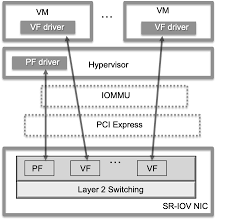Single Root I/O Virtualization (SR-IOV) is a specification that allows a single Peripheral Component Interconnect Express (PCIe) physical device under a single root port to appear as multiple separate physical devices to the hypervisor or the guest operating system. It is an I/O virtualization solution supported by PCIe device hardware and developed by the standardization organization PCI-SIG.
SR-IOV uses physical functions (PFs) and virtual functions (VFs) to manage global functions for the SR-IOV devices. PFs are full PCIe functions that are capable of configuring and managing the SR-IOV functionality. It is possible to configure or control PCIe devices using PFs, and the PF has full ability to move data in and out of the device. VFs are lightweight PCIe functions that support data flowing but have a restricted set of configuration resources.

The number of virtual functions provided to the hypervisor or the guest operating system depends on the device. SR-IOV-enabled PCIe devices require appropriate BIOS and hardware support, as well as SR-IOV support in the guest operating system driver or hypervisor instance.
Each SR-IOV device has one or more physical functions (PF), and each PF has one or more VF corresponding to them. Generally speaking, the PF driver runs in the privileged domain and has the right to access all the resources of the SR-IOV hardware, while the VF driver runs in the non-privileged domain (that is, VMs), and the VF is managed and configured by the PF. VF is a lightweight PCIe device and has the necessary resources to run independently. A VF is like a traditional PCIe device for a VM, with a unique BDF identification number in the PCI bus, so a VF can be bound to a specified VM.
In the SR-IOV NIC device, the bandwidth allocation between multiple VFs is based on the hardware arbitration of the network interface controller (NIC) device, and the bandwidth is allocated in a weighted average manner. Therefore, when the total bandwidth is limited, if the number of VFs is too large, the effective bandwidth acquired by each VF will be inversely proportional to the total number of configured VFs, which will also cause damage to the system network performance.
